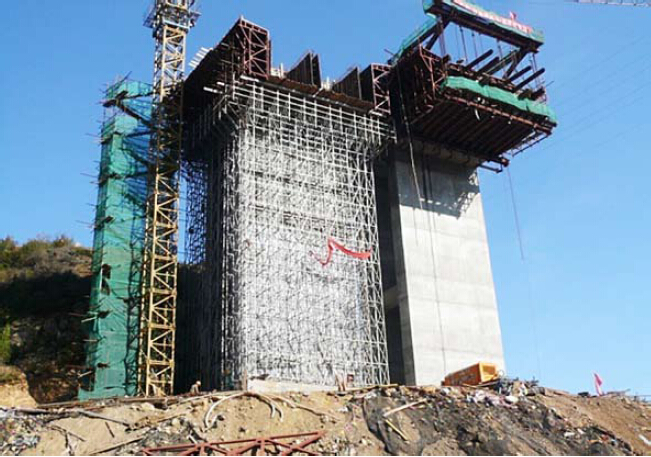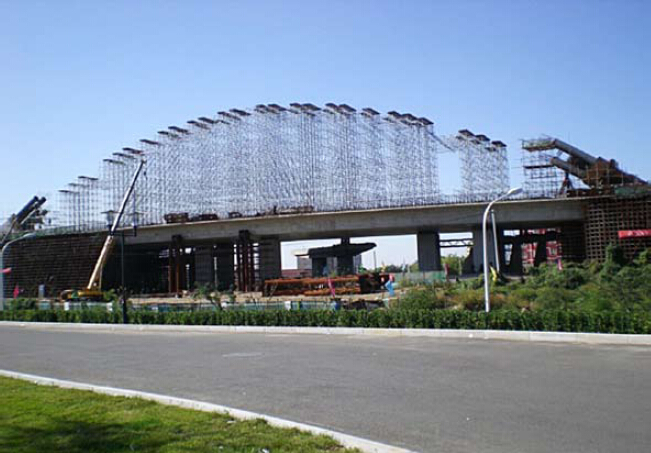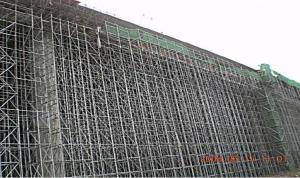Tower scaffolding for formwork and scaffolding system
- Loading Port:
- Tianjin
- Payment Terms:
- TT OR LC
- Min Order Qty:
- 50 m²
- Supply Capability:
- 1000 m²/month
OKorder Service Pledge
Quality Product, Order Online Tracking, Timely Delivery
OKorder Financial Service
Credit Rating, Credit Services, Credit Purchasing
You Might Also Like
Tower Scaffolding
Shoring tower is an effective supporting system. It is easy to assemble and dismantlement, and
has excellent stability and bearing capacity. It has been widely used in the construction of industry
& residential buildings , bridges, tunnels and dam project, etc.
Characteristics:
◆ High degree of standardization.
◆ Easy storage and transportation


- Q:What is the process for installing steel formwork?
- Installing steel formwork involves several steps that must be followed meticulously to achieve a successful and sturdy structure. To begin, the site must be prepared by clearing away any debris or obstacles that could hinder the installation process. It is essential to ensure that the ground is level and stable, providing a strong foundation for the formwork. Next, the steel formwork panels are positioned and firmly secured to create the desired shape and structure. This is typically achieved by connecting the panels using various types of connectors like bolts or clamps. Once the panels are securely connected, it is crucial to align and level the formwork accurately. This guarantees the stability and accuracy of the structure being formed. Specialized leveling devices, such as laser levels or spirit levels, can be utilized to ensure precise alignment and a square formwork. After achieving alignment, reinforcement bars (rebars) are placed within the formwork to enhance strength and support for the poured concrete. These rebars are positioned according to the structural drawings and are securely tied together using wire or metal ties. Once the reinforcement is complete, the concrete is poured into the formwork. Great care must be taken to ensure even pouring without any voids or air pockets. Concrete vibrators can be used to eliminate trapped air and ensure proper compaction. Once the concrete is poured, it needs to be appropriately cured to attain the desired strength and durability. This can be accomplished by covering the formwork with a curing compound or by implementing water curing methods, such as spraying water or covering it with wet burlap. Finally, after the concrete has cured, the formwork can be dismantled. This process involves carefully removing the formwork panels, connectors, and supports. The formwork panels can then be cleaned and stored for future use or transported off-site. Overall, the installation of steel formwork necessitates meticulous planning, precise alignment, and flawless execution to achieve a successful and structurally sound end result.
- Q:Can steel formwork be used in areas with limited labor availability?
- Indeed, in areas where labor is scarce, steel formwork can prove to be an invaluable resource. Renowned for its versatility and durability, this system demands less manpower when compared to traditional formwork techniques. Its assembly and disassembly are effortless, and it can be utilized repeatedly, thus diminishing the necessity for constant labor in formwork construction. Moreover, steel formwork's lightweight nature enables easy transportation to remote regions, rendering it ideal for construction endeavors situated in areas where labor resources are limited. All in all, the employment of steel formwork facilitates an expedited construction process and optimizes labor utilization in regions with restricted labor availability.
- Q:How does steel formwork contribute to the overall constructability of complex structures?
- In enhancing the overall constructability of complex structures, steel formwork plays a crucial role through various means. Firstly, it provides exceptional strength and durability, enabling it to withstand the heavy loads and pressures exerted during construction. This sturdiness ensures the stability and safety of the structure, minimizing the risk of collapse or failure. Furthermore, steel formwork offers immense flexibility and versatility in shaping different architectural elements, allowing for the construction of intricate and complex designs. Its ability to be easily customized and adjusted facilitates the creation of unique and aesthetically pleasing structures. Moreover, compared to traditional formwork systems, steel formwork enhances construction efficiency by enabling faster assembly and disassembly. The ease of installation and removal reduces construction time, resulting in significant cost savings and increased productivity. Additionally, the reusable nature of steel formwork allows for multiple applications, making it a cost-effective choice in the long run. In addition, steel formwork is highly resistant to moisture, chemicals, and extreme weather conditions, ensuring its longevity and minimizing maintenance requirements. This durability makes it particularly suitable for complex structures where long-term reliability is essential. Overall, steel formwork contributes to the overall constructability of complex structures by providing strength, flexibility, efficiency, and durability. Its ability to withstand heavy loads, create intricate designs, and expedite the construction process makes it an invaluable tool in successfully realizing complex architectural projects.
- Q:Can steel formwork be used for both regular and irregular concrete structures?
- Yes, steel formwork can be used for both regular and irregular concrete structures. Steel formwork is highly versatile and can be easily customized to fit any shape or size of the structure. This makes it suitable for constructing both regular structures with standard dimensions as well as irregular structures with unique shapes and designs. The flexibility of steel formwork allows for efficient construction of various types of concrete structures, including walls, columns, beams, slabs, and even complex architectural features. Additionally, steel formwork offers high strength and durability, ensuring that it can withstand the pressure and weight of the concrete during the pouring and curing process, regardless of the structure's regular or irregular shape. Overall, steel formwork is a reliable and adaptable choice for constructing both regular and irregular concrete structures.
- Q:Can steel formwork be used in areas with high seismic vulnerability?
- Certainly! Steel formwork is capable of being utilized in regions with a notable susceptibility to seismic activity. Due to its remarkable strength and durability, steel formwork is well-suited for enduring seismic forces. This inflexible system is capable of withstanding both horizontal loads and vibrations induced by earthquakes. Furthermore, steel formwork can be readily reinforced to heighten its resistance to seismic activity. Nevertheless, it is vital to ensure that proper engineering and design considerations are taken into account in order to effectively anchor and brace the formwork system, allowing it to withstand the specific seismic conditions of the area. In summary, steel formwork presents itself as a feasible choice for construction in regions with high seismic vulnerability; however, it is imperative to exercise appropriate precautions and implement design modifications to guarantee its efficacy.
- Q:Is steel formwork more durable than other types of formwork?
- Compared to other types of formwork, steel formwork is undoubtedly more durable. This is due to the fact that steel is a robust and sturdy material capable of withstanding heavy loads and high pressures. Its resistance to wear and tear makes it ideal for construction projects that involve repetitive use of formwork. Unlike wood or plastic, steel formwork does not easily warp, crack, or deteriorate over time. This exceptional durability allows for multiple concrete pours without the need for frequent replacements, resulting in long-term cost savings. Furthermore, steel formwork's fire-resistant properties further enhance its durability and safety features. In conclusion, steel formwork is a reliable choice for construction projects, offering superior durability when compared to other types of formwork.
- Q:What are the different accessories required for steel formwork maintenance?
- Some of the different accessories required for steel formwork maintenance include formwork release agents, cleaning solutions, wire brushes, repair materials such as epoxy or cementitious grout, lubricants for hinges and pins, and protective coatings for corrosion prevention. Additionally, tools such as hammers, wrenches, and pliers may be needed for minor repairs or adjustments.
- Q:How does steel formwork contribute to better site organization?
- Steel formwork contributes to better site organization in several ways. Firstly, steel formwork is highly durable and reusable, which means it can be used multiple times on different construction projects. This eliminates the need for frequent replacement and reduces waste on site. The ability to reuse steel formwork also reduces storage space requirements, as it can be easily stacked and stored when not in use. Secondly, steel formwork is adjustable and customizable, allowing it to be easily modified to fit different shapes and sizes of concrete structures. This flexibility enables efficient use of space on site, as the formwork can be tailored to the specific requirements of each project. This ensures that the construction process is organized and streamlined, minimizing the need for additional materials or adjustments. Furthermore, steel formwork is known for its high strength and stability, which enhances site safety. Its robust structure provides a secure platform for workers to carry out their tasks, reducing the risk of accidents or injuries. This promotes a safer working environment and improves overall site organization. Steel formwork also contributes to better site organization by facilitating faster construction cycles. Its quick assembly and disassembly process allows for efficient and smooth workflow, enabling construction projects to be completed in a timely manner. This helps to minimize delays and ensures that the site is well-organized and productive. Lastly, steel formwork can be easily integrated with other construction systems and technologies. This compatibility allows for seamless coordination between different components of the project, promoting better site organization. Whether it is integrating with scaffolding systems or connecting to other structural elements, steel formwork ensures a cohesive and well-organized construction site. In conclusion, steel formwork contributes to better site organization through its durability, adjustability, strength, and compatibility with other construction systems. Its ability to be reused, customized, and integrated with other components enhances efficiency, safety, and productivity on construction sites.
- Q:How does steel formwork contribute to the overall structural integrity of a building?
- Steel formwork plays a crucial role in contributing to the overall structural integrity of a building. Firstly, steel formwork provides a robust framework for pouring and shaping concrete, ensuring that it maintains the desired shape and dimensions during the construction process. This is particularly important for complex or irregular structures, where the use of steel formwork allows for accurate and precise construction. Furthermore, steel formwork offers excellent strength and durability, which enhances the structural integrity of the building. Steel is inherently strong and can withstand heavy loads, making it suitable for supporting the weight of concrete and other construction materials. This strength ensures that the formwork remains stable and secure, preventing any potential collapse or deformation during the construction process. Additionally, steel formwork provides excellent dimensional stability, which is vital for maintaining the structural integrity of the building. Steel is resistant to warping, shrinking, or expanding due to changes in temperature or humidity, ensuring that the formwork retains its shape and does not compromise the structural stability of the building. Moreover, the use of steel formwork allows for efficient and speedy construction, which can also contribute to the overall structural integrity of the building. Steel formwork systems are reusable and can be easily assembled and disassembled, enabling faster construction cycles. This reduces the risk of errors or delays, ensuring that the building is constructed in a timely manner and minimizing potential structural issues that may arise from prolonged construction periods. In conclusion, steel formwork is essential for ensuring the overall structural integrity of a building. Its robustness, strength, dimensional stability, and efficiency contribute to the accurate construction and support of the building's structural components, ultimately ensuring its safety and durability.
- Q:What are the different types of formwork release oils used with steel formwork?
- There are several types of formwork release oils that are commonly used with steel formwork. These oils are used to prevent the concrete from sticking to the steel formwork, making it easier to remove after the concrete has set. Some of the different types of formwork release oils used with steel formwork include: 1. Petroleum-based release oils: These release oils are derived from petroleum and are commonly used in construction projects. They provide a good barrier between the concrete and the steel formwork, preventing adhesion and allowing for easy removal. 2. Vegetable-based release oils: Some formwork release oils are made from vegetable oils, such as soybean or canola oil. These oils are considered to be more environmentally friendly compared to petroleum-based oils. 3. Water-based release agents: Water-based release agents are a popular choice as they are non-toxic and do not emit harmful fumes. They are easy to apply and provide a good release effect on steel formwork. 4. Silicone-based release agents: Silicone-based release agents are known for their excellent release properties. They form a thin layer on the steel formwork, preventing adhesion and ensuring easy removal of the concrete. Silicone-based release agents also provide a high-quality finish to the concrete surface. 5. Polymer-based release agents: Polymer-based release agents are commonly used when a high-quality finish is required on the concrete surface. These agents create a thin film on the steel formwork, preventing adhesion and allowing for easy stripping. It is important to select the appropriate formwork release oil based on the specific requirements of the project, including factors such as the type of concrete being used, environmental considerations, and desired finish of the concrete surface. Consulting with a professional or manufacturer's guidelines is recommended to ensure the correct type of release oil is chosen.
1. Manufacturer Overview |
|
|---|---|
| Location | |
| Year Established | |
| Annual Output Value | |
| Main Markets | |
| Company Certifications | |
2. Manufacturer Certificates |
|
|---|---|
| a) Certification Name | |
| Range | |
| Reference | |
| Validity Period | |
3. Manufacturer Capability |
|
|---|---|
| a)Trade Capacity | |
| Nearest Port | |
| Export Percentage | |
| No.of Employees in Trade Department | |
| Language Spoken: | |
| b)Factory Information | |
| Factory Size: | |
| No. of Production Lines | |
| Contract Manufacturing | |
| Product Price Range | |
Send your message to us
Tower scaffolding for formwork and scaffolding system
- Loading Port:
- Tianjin
- Payment Terms:
- TT OR LC
- Min Order Qty:
- 50 m²
- Supply Capability:
- 1000 m²/month
OKorder Service Pledge
Quality Product, Order Online Tracking, Timely Delivery
OKorder Financial Service
Credit Rating, Credit Services, Credit Purchasing
Similar products
New products
Hot products
Hot Searches
Related keywords























